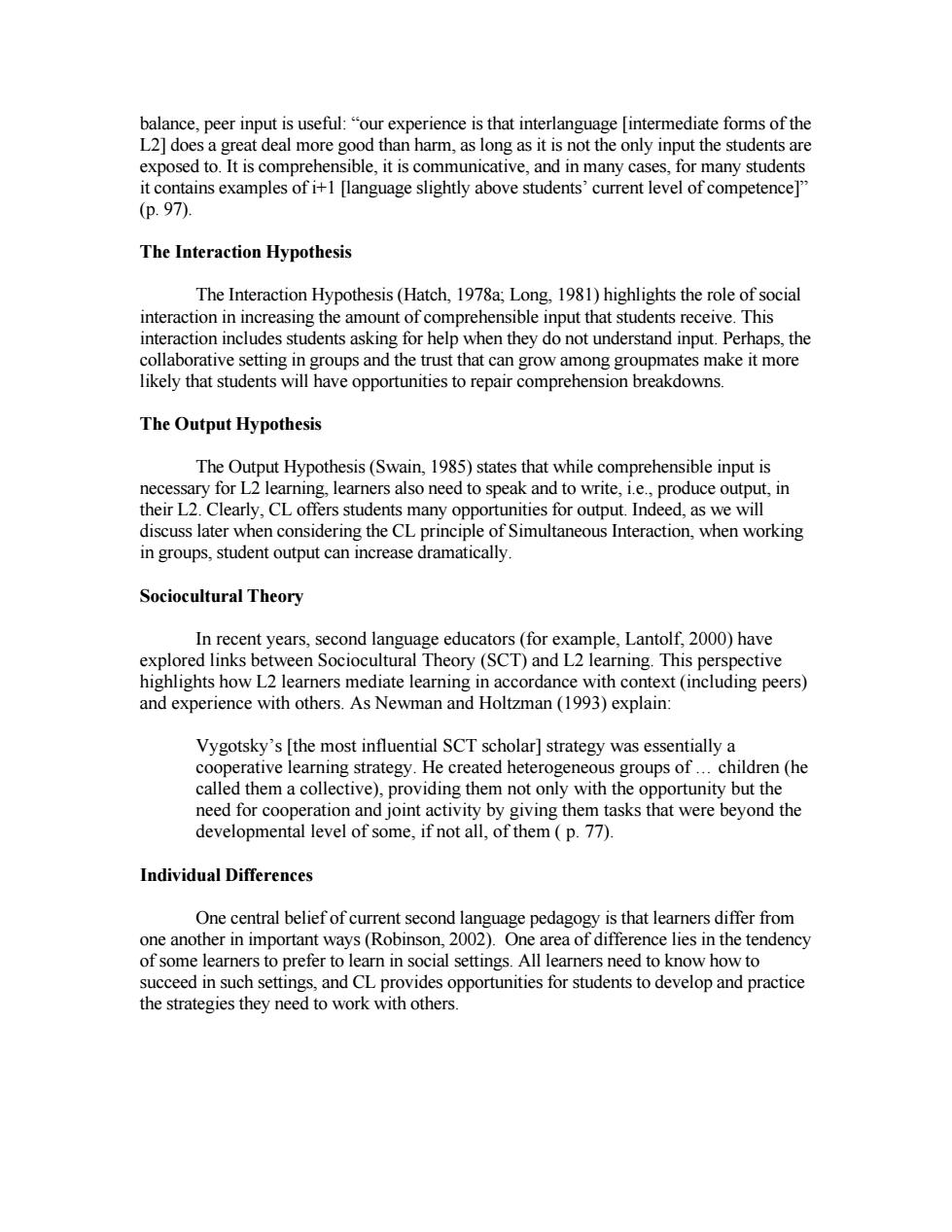正在加载图片...

balance,peer input is useful:"our experience is that interlanguage [intermediate forms of the L2]does a great deal more good than harm,as long as it is not the only input the students are exposed to.It is comprehensible,it is communicative,and in many cases,for many students it contains examples of i+l [language slightly above students'current level of competence]" (p.97 The Interaction Hypothesis The Interaction Hypothesis(Hatch,1978a;Long.1981)highlights the role of social g th mpre npu stude eive.This ction includ s students asking or hel e n they do no t understan erhaps,the roups and e n grow a ong groupm es make it more likely that students will have opportunities to repair comprehension breakdowns The Output Hypothesis The Output Hypothesis(Swain,1985)states that while comprehensible input is necessary for L2 learning,learners also need to speak and to write,i.e.,produce output,in their L2.Clearly,CL offers students many opportunities for output.Indeed,as we will discuss later when considering the CL principle of Simultaneous Interaction,when working in groups,student output can increase dramatically. Sociocultural Theory In recent vears second language educators (for example Lantolf 2000)have explored links betv een so ciocultural Theory(SCT)and L2 learning.This p highlights how L2 le s mediate learnit in acc rdance with c n) and experience with others.As Newman and Holtzman(1993)exp Vygotsky's [the mo st influential SCT scholar]strategy was esse ive lear creat ed heterogene hildrer n (he providing them not only portunity but th need for cooperation and jo giving them tasks that were beyond the developmental level of some,if not all,of them(p.77) Individual Differences One central belief of current second language pedagogy is that learners differ from one another in important ways(Robinson,2002).One area of difference lies in the tendency of some learners to prefer to learn in social settings.All learners need to know how to succeed in such settings,and CL provides opportunities for students to develop and practice the strategies they need to work with others.balance, peer input is useful: “our experience is that interlanguage [intermediate forms of the L2] does a great deal more good than harm, as long as it is not the only input the students are exposed to. It is comprehensible, it is communicative, and in many cases, for many students it contains examples of i+1 [language slightly above students’ current level of competence]” (p. 97). The Interaction Hypothesis The Interaction Hypothesis (Hatch, 1978a; Long, 1981) highlights the role of social interaction in increasing the amount of comprehensible input that students receive. This interaction includes students asking for help when they do not understand input. Perhaps, the collaborative setting in groups and the trust that can grow among groupmates make it more likely that students will have opportunities to repair comprehension breakdowns. The Output Hypothesis The Output Hypothesis (Swain, 1985) states that while comprehensible input is necessary for L2 learning, learners also need to speak and to write, i.e., produce output, in their L2. Clearly, CL offers students many opportunities for output. Indeed, as we will discuss later when considering the CL principle of Simultaneous Interaction, when working in groups, student output can increase dramatically. Sociocultural Theory In recent years, second language educators (for example, Lantolf, 2000) have explored links between Sociocultural Theory (SCT) and L2 learning. This perspective highlights how L2 learners mediate learning in accordance with context (including peers) and experience with others. As Newman and Holtzman (1993) explain: Vygotsky’s [the most influential SCT scholar] strategy was essentially a cooperative learning strategy. He created heterogeneous groups of … children (he called them a collective), providing them not only with the opportunity but the need for cooperation and joint activity by giving them tasks that were beyond the developmental level of some, if not all, of them ( p. 77). Individual Differences One central belief of current second language pedagogy is that learners differ from one another in important ways (Robinson, 2002). One area of difference lies in the tendency of some learners to prefer to learn in social settings. All learners need to know how to succeed in such settings, and CL provides opportunities for students to develop and practice the strategies they need to work with others